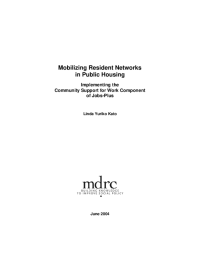Mobilizing Resident Networks in Public Housing
Implementing the Community Support for Work Component of Jobs-Plus
Is it possible for an employment program to engage public housing residents in services and activities by tapping the social networks that exist in their developments? The Jobs-Plus Community Revitalization Initiative for Public Housing (“Jobs-Plus” for short), a multifaceted effort to use rent incentives, job counseling, and other inducements to help increase residents’ employment and earnings, attempted this approach. One of the program's most distinctive features, a unique component called “community support for work,” focused on the recruitment of outreach workers from among the residents of seven public housing developments. The aim was to harness the knowledge and relationships of resident leaders to advance the employment goals of Jobs-Plus. Jobs-Plus administrators identified and trained resident outreach workers to serve as bridges between their neighbors and professional program staff. Mobilizing residents in this way extended Jobs-Plus’s reach in the community by facilitating neighbor-to-neighbor exchanges about program services, rent policies, and job opportunities.
Key Findings
- Outreach workers added to Jobs-Plus’s credibility among the larger tenant population. By giving the program a familiar “face,” outreach workers helped make Jobs-Plus more accessible to fellow residents and boosted turnout for program services and activities. At ethnically diverse developments, outreach workers from different language groups brought wary immigrants into Jobs-Plus.
- Recruitment of outreach workers had to be selective and ongoing. Jobs-Plus aimed to enlist widely respected and well-connected residents who were employed, participating in job-related training or studies, or retired, and who were eager to help the community. Recruiting such people was not easy, and maintaining an effective team of outreach workers required sustained efforts, as many workers moved out of their developments or went to work.
- Formal program oversight of the community support for work component was essential. Outreach workers were extensions of the program, not an independent resident association. To keep them energetically focused on Jobs-Plus’s employment goals, the sites found it important to pay the outreach workers a stipend for their efforts; assign staff to supervise them; and equip them with task-specific training about program services, outreach skills, and team building.
- Maintaining outreach workers’ independence from the housing authority was challenging but critical to their effectiveness. Because outreach workers were employed by Jobs-Plus, some residents suspected them of being agents of the housing authority. Their positions required careful training in confidentiality issues and their assignment to perform tasks that would not compromise their standing in the community. Serious public-safety issues at some sites also hindered them from going freely door-to-door.
- The Jobs-Plus community support for work component offered residents new possibilities for civic leadership development. In Los Angeles, the outreach workers demonstrated that a community support for work component could further the development of residents’ leadership potential. The skills derived from their Jobs-Plus experience enabled outreach workers to take the lead in bringing an array of services on-site and to sustain high turnout- and completion-levels for education and training courses.
A subsequent report will determine whether the package of Jobs-Plus services, financial incentives, and community supports succeeded in improving public housing residents’ employment, earnings, and quality-of-life outcomes.






